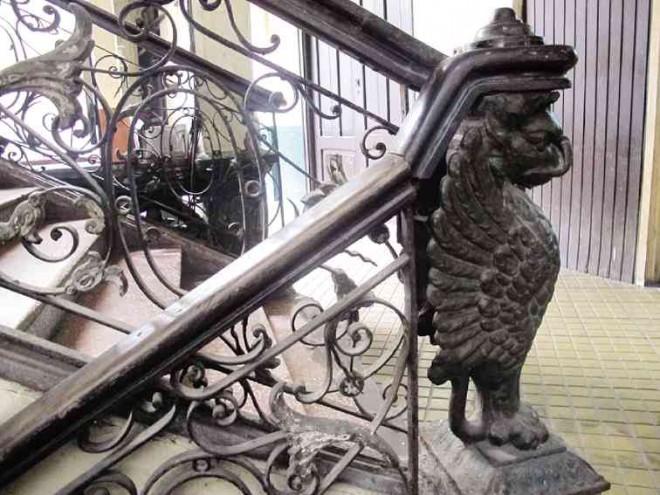
spaces from the interior courtyard.
The landmark El Hogar Filipino building on the Binondo bank of the Pasig is reported to have been sold.
Conservationists ask for assurance that the new owner will preserve the heritage structure. But why should its new owner preserve El Hogar? Are there any incentives to encourage him to do so?
El Hogar is an outstanding Manila landmark located a few buildings to the west of Jones Bridge, on the corner of Juan Luna and Muelle de la Industria Streets in Binondo.
Built in 1914, it was the headquarters of the country’s first savings and loan association that gave it the name of El Hogar Filipino (The Filipino Home).
It is one of the last surviving classically inspired office buildings in the city. The building itself, designed by the architects Irrureta Goyena and Perez Muñoz, is a Manila architectural standout.
It is an environmentally attuned building, like the buildings of its era were. All its offices are naturally ventilated by windows on two sides of the space that open out to the street and to the arcaded corridors that encircle an open interior courtyard.
The intricate iron grillwork, staircase at the center of the courtyard, and architectural detailing are all outstanding.
For heritage’s sake, the building should obviously be preserved. But is heritage the overriding reason to preserve a building?
Many owners see their heritage buildings as white elephants. Not only is the property expensive to maintain, its development opportunities are severely limited by conservation laws.
“Developmental possibilities of a heritage structure, including the area around it, are limited by law,” says Victor Venida, Economics professor at the Ateneo de Manila University.
“This means that the current owner can still sell but cannot realize the full market value of the lot and its location precisely because the building may not be demolished and thus it will impose limitations on commercial possibilities for the buyer.
“The lot itself has a value greater than the building, but if the building cannot be demolished then the value [of the lot] will be less. Government can provide for incentives to the developer to maintain the building and reuse it.”
Many heritage structures today are in inner-city locations where real-estate values are high. The pressure for owners to cash in on their properties is very real. Therefore, what incentives do owners receive for preserving their heritage structures?
No laws
“Currently there are no laws or ordinances, to my knowledge, that provide for property tax reduction because of the cost of maintaining a heritage structure,” says Venida. “Our laws do not provide owners with tax incentives for protection of the property on which the heritage structure stands.”
Republic Act 10066, the National Cultural Heritage Act, specifically mandates the preservation of heritage structures, especially those marked to be of historic significance by the National Historical Commission of the Philippines (NHCP) or declared by the National Museum as National Cultural Treasures.
Therefore, the appropriate agency with jurisdiction over the structure must approve any alterations to the original structure, a threatening legal proviso for heritage building owners.
There are no specific guidelines to illustrate what development is permissible for heritage structures.
What options are available to an owner who wishes to cash in on his heritage asset?
Venida further says: “The owner can still cash in but not at the maximum price of the lot; the maximum price would mean just the value of the lot which means the buyer means to demolish the building and replace it with a more profitable structure than an old building with adaptive reuse. The value of the lot with the [heritage] building is much less.
“Once sold, the onus now is on the new owner to spend on its adaptive reuse; can the current owner of El Hogar Filipino imitate what the owners of the nearby building did?” (She is referring to the former First National City Bank of New York headquarters across the street, now restored and reused as the Juan Luna e-Services Building, a call center hub.)
“The problem is that, as you put it, existing laws do not provide tax incentives for maintaining old buildings,” the economist adds. “But at the same time, preserving an old building means that the owner cannot cash in fully because the full market price is on the lot as empty space, which would mean demolition. The owner might have to accept a lower value but the new owner must also preserve it, which is more expensive than demolition and construction of a new building.”
Preserving heritage is well and good, but without solid incentives, it is difficult to make owners agree to continue preserving the heritage in their care. Decaying structures that require high maintenance have limited development opportunities. They are also subject to high real-estate taxes.
To many heritage structure owners, psychic rewards are not enough.
Comments are invited to pride.place@gmail.com.